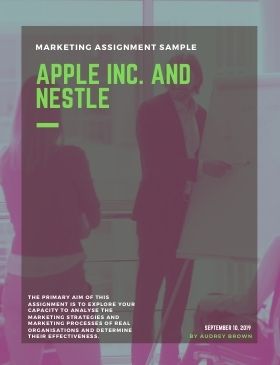You can download the sample Linguistics case study on Japanese Comics and Religion: Osamu Tezuka's Story of the Buddha with the following question for free at the end of this page. For further assistance with Linguistics Assignment help, please check our offerings in Linguistics assignment solutions. Our subject-matter experts provide online assignment help to Linguistics students from across the world and deliver plagiarism free solution with a free Turnitin report with every solution.
(AssignmentEssayHelp does not recommend anyone to use this sample as their own work.)
Marketing Assignment Question
Aim: The primary aim of this assignment is to explore your capacity to analyse the marketing
strategies and marketing processes of real organisations and determine their effectiveness. It also aims to determine your ability to analyse such practical matters using early concepts (such as marketing intelligence, market segmentation and target marketing to name a few examples) covered in the formative weeks of the unit.
Core Task:
Basing your arguments on the academic literature that you have studied in the first six topics of this unit, write a report on the ways two different organisations have been able to compete in their markets. Your report should discuss the following points about each of the two organisations:
1. Evidence that the organisation has a gain a competitive advantage from their marketing processes.
2. Theoretical analysis of the reasons for the achievement of this advantage.
Your discussion is to be based on two suitable published case studies. This means case studies published in the academic literature – for example, the series of case studies in a textbook, or published in journals etc. Case studies and short articles in newspapers, magazines, website opinion pages and the like are definitely not acceptable, although such materials may be used to supplement
the published case study and your analysis. All sources must be properly referenced. If in any doubt about the suitability of a case study, seek an early ruling from your tutor. This is a substantial piece of scholarly work and will require extensive engagement with both unit theory and at least two detailed case studies.
Process:
1. Choose your two cases. They all need to be published cases in academic sources (e.g. textbooks, journal articles). It is obviously important that each case represents an instance of
a company achieving a clear success in terms of their marketing function.
2. Analyse and locate evidence. Begin to analyse each case in terms of the two questions – particularly question one listed previous. It is vital that you respond to both questions, but the evidence successful marketing practice is more likely to be in the case material itself. It is in this part of the process that you might bring in supplemental material from company
documents/websites, media analysis and so on. Be sure to reference all sources properly. You need to try and show clear and where possible objective evidence of sustained competitive advantage.
3. Analyse and explain. You need to move from the presentation of evidence to explaining how the company/organisation was able to achieve its success through its strategies. This part of the assignment requires you to consider any aspect of the marketing strategy process and/or any aspect of the organisations' marketing-based strategising that you think has enabled them to sustain their competitive advantage. You will need to show that you understand relevant theories and concepts from the course and that you can apply them to an analysis and assessment of different companies' marketing actions and performance. Consider using
relevant models and theoretical perspectives to make your analysis. For example, you might find that one successful organisation has executed its marketing strategy by applying Ansoff's Matrix in a disciplined manner, whereas another successful organisation has executed a successful marketing strategy by consistently exploiting some interesting form of customer
segmentation. You may find an opportunity to critique various concepts and theoretical positions through seeing how they apply or don't apply to your case organisations. Evidence that you understand and can use tools discussed in the early topics of the unit will add value.
4. Write up. On completing your analysis, you obviously need to write it up. You should respond to this task in report format, with headings and subheadings used to help readers understand the structure of your paper. A possible structure might be:
a. An introduction which both sets up the task and the rest of the paper, and introduces the core concepts that the task is designed to deal with. You might also take this chance to scope the work – for example the time frame that will be used to assess the
marketing success for the case organisations.
b. Description of the two cases. Describe each case, each organisation and the sources of your information.
c. Evidence of Marketing-related success (leading through to a competitive advantage for the firm). Marshal all the evidence that you can that you think reveals that each organisation has well and truly found success in the marketing realm.
d. Analysis and Explanation. Provide a detailed analysis of how each organisation achieved its success in marketing terms.
e. Conclusion. Summarise the key points and what can be learnt from the overall analysis.
Marketing Assignment Solution
The current study is about analyzing and discussing the marketing strategies implemented by two renowned organizations that have helped in attaining competitive advantages to these organizations. For the same two very successful organizations Nestle and Apple Inc. have been selected. While discussing the effectiveness of the marketing strategies of both these organizations, the marketing concepts like Marketing Mix, strategic planning, and segmentation, targeting and positioning would be discussed. The case study discussed and analyzed for Apple Inc. is about the successful launch of iPhone through effective marketing. In case of Nestle, the case study analysis is about the evolution of Nestle from an infant food maker of the largest Food and Beverage Company of the world as a customer-oriented organization through the implementation of R&D based marketing approach
Case Studies
Apple’s iPhone Launch: A Case Study in Effective Marketing (Mickalowski, Mickelson, & Keltgen, 2008)
The announcement to launch iPhone was made by in the year 2007, and within the span of one year the stock price of Apple more than doubled. Almost $400 Million were invested in the publicity of iPhone between the time span of the announcement to launch. Vigorous and aggressive paid as well as non-paid marketing was done for iPhone. The idea was to mark a constant presence in every form of media that is popular right from newspapers, television to Academy awards. A combination of the iPod and smartphone were the innovative product features of iPhone, and it was targeted towards high-end customers, priced at $499 and $599. Apple entered into strategic partnerships with AT&T to launch iPhone, which came with the requirement of iPhone customers to enter into an agreement with AT&T, to use AT&T network for two years, but this deal didn't shudder much of the potential customers because of trust and reputation attached with Apple Inc. Competitors like Nokia and LG couldn't hurt iPhone's popularity in the U.S.A, despite offering more features due to the absence of U.S. based distributors. Apple shunned third-party distributors for distributing iPhone and distributed through Apple stores, online stores as well as official AT&T stores. Apple sold 4 Million sets in the period of 6 months, grabbed a market share of 19.5% and became the most popular handset of the year.
Responding to changing customer requirements: the drive towards Wellness: A Nestlé case study (Business Case Studies, 2010)
From a baby food maker to becoming the largest food and beverage company, Nestle developed itself around identifying customer needs, identifying pressures like healthy campaigns that reinforce these needs and responding to them. Nestle conducts both qualitative and quantitative research in order to gain consumer insights through liaisons with scientists and product developers. It invests more than any other company of the food industry on Research and development and has the largest nutrition based science research unit of the world. Sveltesse or 'Slimness' range of food and beverage is an outcome Nestles' excellent R&D. It is inspired by awareness among customers towards delicious and low-fat products. In terms of marketing strategy, Nestle has adopted 'Wellness' strategy, which is about health, good physical state, good diet and being in good shape. Through its wellness strategy, Nestle emphasizes more on the Nutritional aspect of foods it produces. The three-step strategy implemented by Nestle makes it the world leader, which is: Retaining Healthy products, improving the existing ones, and developing new products through innovation which reflects the wellness criteria. Nestle has a well-established wellness unit to take care of this. The strategy of Nestle is simple: produce quality products, strive to improve them and stay close to customers for learning about their evolving ideas and needs with respect to health, nutrition, and wellness.
Evidence of Marketing related success
Apple Inc.
Immensely loyal evangelist customer base, leadership in innovation and the title of being the most valuable brand of the world are the biggest competitive advantages of Apple. The contribution of iPhone has been significant in helping it to become the leader of the IT industry. Currently, Apple Inc. has been listed as the most valuable brand of the world by Forbes (Forbes, 2015). It is the largest IT Company in the world in terms of revenue and total assets, and the third largest smartphone maker in the world. iPhone is considered as the cash cow of Apple. Out of the massive $49.6 billion revenue of Apple in the first quarter of 2015, iPhone contributed $31.4 billion in Apple's revenue (Associated Press, 2015) As per Steve Jobs, the loyal customer base of Apple Inc. which is its biggest competitive advantage is not an outcome of something fictitious like 'Mac Church', but from the conviction to deliver outstanding products consistently by not cutting corners (Klaiber, 2013).
(Some parts of the solution has been blurred due to privacy protection policy)



 WhatsApp Us
WhatsApp Us